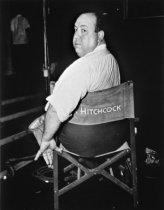
HITCHCOCK, SELZNICK & HOLLYWOOD
"Tylsintä elokuvan tekemisessä on sen kuvaaminen. Olen tehnyt sen kaiken jo mielessäni. Joka kuvan ja leikkauksen. Kaiken."
 Kuvaava tokaisu elokuvan yhdeltä mestarilta, Alfred Hitchcockilta, jonka maine ja kunnia kasvoi elokuva elokuvalta, kun hän lähti Englannista Amerikkaan 1939 ja toi oman modernin näkemyksensä mukanaan.
Kuvaava tokaisu elokuvan yhdeltä mestarilta, Alfred Hitchcockilta, jonka maine ja kunnia kasvoi elokuva elokuvalta, kun hän lähti Englannista Amerikkaan 1939 ja toi oman modernin näkemyksensä mukanaan.
Aivan toisenlaista, kontrolloidun perinteistä elokuvan tekemistä edusti Hollywoodin tuottajakomeetta David O. Selznick, jonka kuuluisin elokuva on Tuulen viemää. Tuotannoissaan Selznick kulutti loppuun niin ohjaajia kuin käsikirjoittajiakin, ja hän laittoi rahaa palaamaan sekä yksityiselämässään että tuotantoprosesseissa.
Kaikista teoistaan huomattavimmaksi elokuvan historiassa nousi kuitenkin elokuvien sijasta englantilaisen katolilaisperheen ylipainoisen ja ujon vesan tuottaminen Amerikkaan.
Hitchcock, Selznick & Hollywood -dokumentti kertoo näiden kahden miehen seitsemästä yhteisestä vuodesta 1940-luvun taiteessa, kun tuottajan nimi koreili elokuvissa isolla, eikä kukaan oikeastaan piitannut ohjaajasta. Hitchcock muutti tuon pikkuseikan elokuvien Rebecca (1940), Noiduttu, (Spellbound, 1945) ja Notorious - kohtalon avain (Notorious 1946)avulla.
Dokumentti kertoo monien työtovereiden ja näyttelijöiden suulla alle kolmekymppisenä oman elokuvanstudion omistaneesta Selznickistä, hänen voitoistaan ja tuhostaan. Monet mustavalkoiset kuvat ja elokuvaotot kertovat Selznickin ja Hitchcockin suhteen kehittymisestä ja keskinäisen työsopimuksen päättymisestä.
Selznick sai parhaan elokuvan Oscarin kahtena vuonna peräkkäin elokuvista Tuulen viemää ja Rebecca, kun taas Hitchcock ei voittanut useista ehdokkuuksistaan huolimatta yhtäkään.
Kaikesta elokuvan tekemisen intohimosta huolimatta, Selznick epäili, että hänet muistetaan vain Tuulen viemästä ja ironista kyllä, kun hän kuoli 1965 63-vuotiaana, juuri näin kävi.
Hitchcockin ura jatkoi nousemistaan, ja hänen nimensä oli elokuvajulisteissa yhtä isolla kuin pääosien näyttelijöiden. Takaikkunassa on huvittava yksityiskohta: murhasta epäilty naapuritalon mies näyttää erehdyttävästi Selznickiltä.
1960 Alfred Hitchcock muutti elokuvan historiaa yhdellä elokuvalla, aivan kuten Selznick teki kaksi vuosikymmentä aikaisemmin. Elokuvassa Psyko ei mikään ollut perinteistä. Sankaritar kuolee ennen elokuvan puolta väliä, suihkukohtaus oli ennennäkemättömän väkivaltainen ja Hitchcock maksoi kaiken omasta pussistaan.
- Ohjaaja: Michael Epstein
- Tuotanto: PBS, USA, 1999
In English In English In English
HITCHCOCK, SELZNICK & THE END OF HOLLYWOOD
 On December 10, 193 8 David 0. Selznick burned down Atlanta. On the back lot of his Culver City studio, Selznick had just begun what was to be the greatest, most lavish film of the golden age of Hollywood, Gone With The Wind. As the flames roared, phones at the local precincts rang off the hook. "MGM is burning down!" they screamed. "No," came the reply, "David 0. Selznick is at work."
On December 10, 193 8 David 0. Selznick burned down Atlanta. On the back lot of his Culver City studio, Selznick had just begun what was to be the greatest, most lavish film of the golden age of Hollywood, Gone With The Wind. As the flames roared, phones at the local precincts rang off the hook. "MGM is burning down!" they screamed. "No," came the reply, "David 0. Selznick is at work."
But was during Gone With The Wind that Selznick made his most lasting contribution to American film making. Oddly, it was one that had nothing to do with his grand Southern epic, for in the summer of 1939 David 0. Selznick brought Alfred Hitchcock to Hollywood
Hitchcock had already tasted fame with his British thrillers The Man Who Knew Too Much and The Thirty-Nine Steps. No one was as successful in England, or as well known. No one approached Hitchcock's command of the medium. He meticulously planned every shot, knowing exactly what he needed to achieve his desired effect. In fact, the way Hitchcock approached movie making was a world apart from Selznick's uncontrolled, indecisive ways. But Hitchcock wanted to come to Hollywood, and no one else would have him.
Each man was used to asserting more control than the other was willing to give up, and it was this dynamic that defined their relationship. Selznick announced that Hitchcock's first production would be The Titanic. Hitchcock had other ideas. "I remember thinking that the only way to make it cinematic would be to start the opening credits on a tight close-up of a huge rivet on the side of the ship," he later said. "The camera would then dolly back as the credits roll--slowly, very slowly--and two hours later the audience would at last see the whole ship in long shot and 1 would flash the words The End. " Instead Hitchcock's first project was a film he was desperate to make, Rebecca.
On Rebecca, Hitchcock did not yet have the power or position to make a movie his way. He was lucky; Selznick's contributions added immeasurably to Rebecca. When Hitchcock delivered his forty-five page, double-spaced treatment Selznick ripped into it, and into Hitchcock. "I am shocked and disappointed beyond words,"
By the time Notorious was made the balance of power had shifted. Selznick had lost his magic touch. Desperate for cash because of overruns on his bloated western Duel in the Sun, Selznick sold Notorious to RKO while it was still in pre-production. Hitchcock was a star now in his own right, and he would produce as well as direct the picture. More significantly, his name would appear above the title along with its stars, Ingrid Bergman and Cary Grant. Selznick's was nowhere to be found. Many consider it to be their best collaboration.
Hitchcock in Hollywood is an epic documentary which covers the lives of two Hollywood masters. Told through reminiscence of friends, family, and the actors who worked with them, as well as home movies, stock footage, and the pictures they made together the documentary will offer a window into the characters of David 0. Selznick and Alfred Hitchcock. But ours is also the story of Hollywood, its excess, its power struggles, and ultimately its transformation to the system we know today.
- Director: Michael Epstein
- Production: PBS, USA, 1999

Päivitys:31.1.2000 U.E.